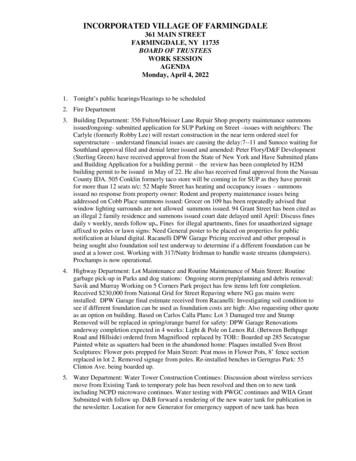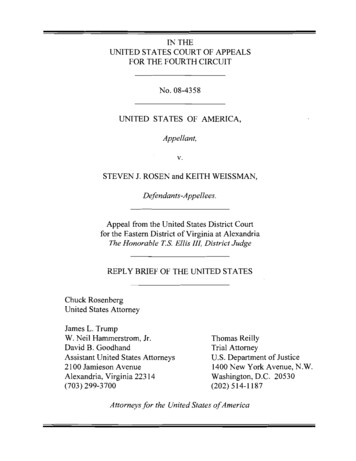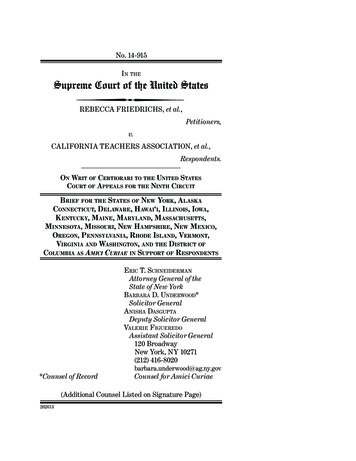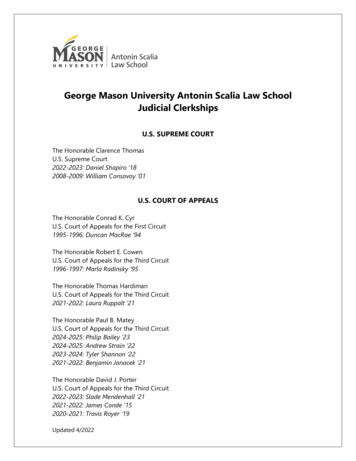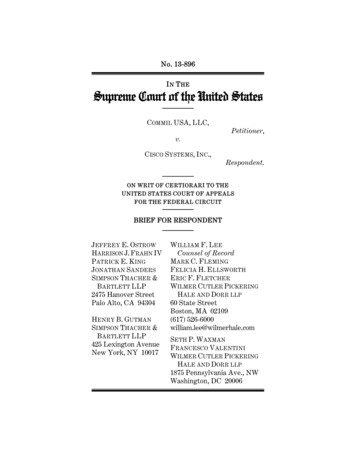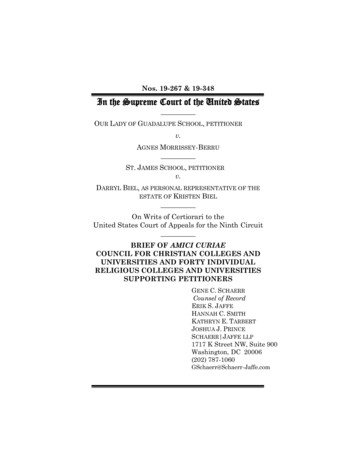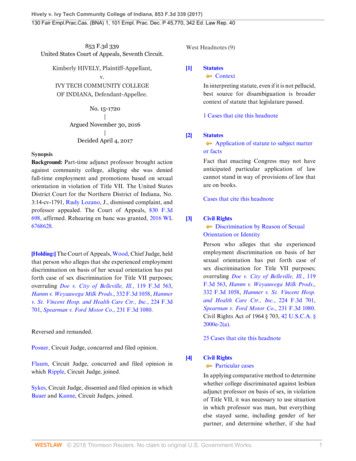
Transcription
Hively v. Ivy Tech Community College of Indiana, 853 F.3d 339 (2017)130 Fair Empl.Prac.Cas. (BNA) 1, 101 Empl. Prac. Dec. P 45,770, 342 Ed. Law Rep. 40853 F.3d 339United States Court of Appeals, Seventh Circuit.Kimberly HIVELY, Plaintiff-Appellant,v.IVY TECH COMMUNITY COLLEGEOF INDIANA, Defendant-Appellee.No. 15-1720 Argued November 30, 2016 Decided April 4, 2017SynopsisBackground: Part-time adjunct professor brought actionagainst community college, alleging she was deniedfull-time employment and promotions based on sexualorientation in violation of Title VII. The United StatesDistrict Court for the Northern District of Indiana, No.3:14-cv-1791, Rudy Lozano, J., dismissed complaint, andprofessor appealed. The Court of Appeals, 830 F.3d698, affirmed. Rehearing en banc was granted, 2016 WL6768628.West Headnotes (9)[1]StatutesContextIn interpreting statute, even if it is not pellucid,best source for disambiguation is broadercontext of statute that legislature passed.1 Cases that cite this headnote[2]StatutesApplication of statute to subject matteror factsFact that enacting Congress may not haveanticipated particular application of lawcannot stand in way of provisions of law thatare on books.Cases that cite this headnote[3]Civil RightsDiscrimination by Reason of SexualOrientation or IdentityPerson who alleges that she experiencedemployment discrimination on basis of hersexual orientation has put forth case ofsex discrimination for Title VII purposes;overruling Doe v. City of Belleville, Ill., 119F.3d 563, Hamm v. Weyauwega Milk Prods.,332 F.3d 1058, Hamner v. St. Vincent Hosp.and Health Care Ctr., Inc., 224 F.3d 701,Spearman v. Ford Motor Co., 231 F.3d 1080.Civil Rights Act of 1964 § 703, 42 U.S.C.A. §2000e-2(a).[Holding:] The Court of Appeals, Wood, Chief Judge, heldthat person who alleges that she experienced employmentdiscrimination on basis of her sexual orientation has putforth case of sex discrimination for Title VII purposes;overruling Doe v. City of Belleville, Ill., 119 F.3d 563,Hamm v. Weyauwega Milk Prods., 332 F.3d 1058, Hamnerv. St. Vincent Hosp. and Health Care Ctr., Inc., 224 F.3d701, Spearman v. Ford Motor Co., 231 F.3d 1080.Reversed and remanded.25 Cases that cite this headnotePosner, Circuit Judge, concurred and filed opinion.Flaum, Circuit Judge, concurred and filed opinion inwhich Ripple, Circuit Judge, joined.Sykes, Circuit Judge, dissented and filed opinion in whichBauer and Kanne, Circuit Judges, joined.[4]Civil RightsParticular casesIn applying comparative method to determinewhether college discriminated against lesbianadjunct professor on basis of sex, in violationof Title VII, it was necessary to use situationin which professor was man, but everythingelse stayed same, including gender of herpartner, and determine whether, if she had 2018 Thomson Reuters. No claim to original U.S. Government Works.1
Hively v. Ivy Tech Community College of Indiana, 853 F.3d 339 (2017)130 Fair Empl.Prac.Cas. (BNA) 1, 101 Empl. Prac. Dec. P 45,770, 342 Ed. Law Rep. 40been a man married to a woman, collegewould have refused to promote her and wouldhave fired her. Civil Rights Act of 1964 § 703,42 U.S.C.A. § 2000e-2(a).on basis of sexual orientation fell withinscope of Title VII's prohibition againstsex discrimination by failing to advancearguments to district court, where argumentswent against controlling precedent thatdistrict court was powerless to overturn,arguments turned on pure issues of law, andCourt of Appeals was proceeding on de novobasis. Civil Rights Act of 1964 § 703, 42U.S.C.A. § 2000e-2(a).1 Cases that cite this headnote[5]Civil RightsPractices prohibited or required ingeneral; elementsCivil RightsPersonal appearance; hair and groomingCivil RightsDiscrimination by Reason of SexualOrientation or IdentityAny discomfort, disapproval, or job decisionbased on fact that complainant—woman orman—dresses differently, speaks differently,or dates or marries same-sex partner, isreaction purely and simply based on sex, andthus falls within Title VII’s prohibition againstsex discrimination if it affects employment inspecified way. Civil Rights Act of 1964 § 703,42 U.S.C.A. § 2000e-2(a).11 Cases that cite this headnote[6]Civil RightsOther particular bases or classesPerson who is discriminated against becauseof protected characteristic of one with whomshe associates is actually being disadvantagedbecause of her own traits.Cases that cite this headnote[7]Federal CourtsIn general; necessityCourt of Appeals has discretion to addressissues for first time on appeal.2 Cases that cite this headnote[8]Federal CourtsMatters of SubstanceFormer employee did not waive argumentsin support of her claim that discrimination32 Cases that cite this headnote[9]Federal CourtsCivil rights and discrimination in generalCongress validly abrogated state's immunitywith respect to intentional discriminationclaims under Title VII. U.S. Const. Amend.11; Civil Rights Act of 1964 § 703, 42 U.S.C.A.§ 2000e-2(a).2 Cases that cite this headnote*340 Appeal from the United States District Court forthe Northern District of Indiana, South Bend Division.No. 3:14-cv-1791—Rudy Lozano, Judge.Attorneys and Law FirmsGregory R. Nevins, Attorney, Lambda Legal Defense& Education Fund, Atlanta, GA, Jon W. Davidson,Attorney, Lambda Legal Defense And Education Fund,Inc., Los Angeles, CA, Omar Gonzalez-Pagan, Attorney,Lambda Legal Defense & Education Fund, New York,NY, for Plaintiff–Appellant.Adam Lee Bartrom, Jason T. Clagg, Attorneys, Barnes& Thornburg LLP, Fort Wayne, IN, John Robert Maley,Attorney, Barnes & Thornburg LLP, Indianapolis, IN, forDefendant–Appellee.Shannon Price Minter, Attorney, National Center forLesbian Rights, San Francisco, CA, for Amicus CuriaeNational Center for Lesbian Rights.Mary Lisa Bonauto, Attorney, Gay & Lesbian Advocates& Defenders, Boston, MA, for Amicus Curiae GLBTQLegal Advocates & Defenders. 2018 Thomson Reuters. No claim to original U.S. Government Works.2
Hively v. Ivy Tech Community College of Indiana, 853 F.3d 339 (2017)130 Fair Empl.Prac.Cas. (BNA) 1, 101 Empl. Prac. Dec. P 45,770, 342 Ed. Law Rep. 40Gail S. Coleman, Attorney, Equal EmploymentOpportunity Commission, Washington, DC, for AmicusCuriae Equal Employment Opportunity Commission.Ria Tabacco Mar, Attorney, American Civil LibertiesUnion, New York, NY, for Amicus Curiae America CivilLiberties Union.Evan Chesler, Attorney, Cravath, Swaine & Moore, NewYork, NY, for Amicus Curiae Five Members of Congress.Before Wood, Chief Judge, and Bauer, Posner, Flaum,Easterbrook, Ripple, Kanne, Rovner, Williams, Sykes,and Hamilton, Circuit Judges.OpinionWood, Chief Judge.Title VII of the Civil Rights Act of 1964 makes itunlawful for employers subject to the Act to discriminateon the basis of a person’s “race, color, religion, sex,or national origin.” 42 U.S.C. § 2000e-2(a). Formany years, the courts of appeals of this countryunderstood the prohibition against sex discrimination toexclude discrimination on the basis of a person’s sexualorientation. The Supreme Court, however, has neverspoken to that question. In this case, we have beenasked to take a *341 fresh look at our position in lightof developments at the Supreme Court extending overtwo decades. We have done so, and we conclude todaythat discrimination on the basis of sexual orientation isa form of sex discrimination. We therefore reverse thedistrict court’s judgment dismissing Kimberly Hively’ssuit against Ivy Tech Community College and remand forfurther proceedings.IHively is openly lesbian. She began teaching as a parttime, adjunct professor at Ivy Tech Community College’sSouth Bend campus in 2000. Hoping to improve her lot,she applied for at least six full-time positions between2009 and 2014. These efforts were unsuccessful; worseyet, in July 2014 her part-time contract was not renewed.Believing that Ivy Tech was spurning her because of hersexual orientation, she filed a pro se charge with the EqualEmployment Opportunity Commission on December 13,2013. It was short and to the point:I have applied for several positionsat IVY TECH, fulltime, in the last 5years. I believe I am being blockedfrom fulltime employment withoutjust cause. I believe I am beingdiscriminated against based on mysexual orientation. I believe I havebeen discriminated against and thatmy rights under Title VII of the CivilRights Act of 1964 were violated.After receiving a right-to-sue letter, she filed this action inthe district court (again acting pro se). Ivy Tech respondedwith a motion to dismiss for failure to state a claimon which relief can be granted. It argued that sexualorientation is not a protected class under Title VII or 42U.S.C. § 1981 (which we will disregard for the remainderof this opinion). Relying on a line of this court’s casesexemplified by Hamner v. St. Vincent Hosp. and HealthCare Ctr., Inc., 224 F.3d 701 (7th Cir. 2000), the districtcourt granted Ivy Tech’s motion and dismissed Hively’scase with prejudice.Now represented by the Lambda Legal Defense &Education Fund, Hively has appealed to this court. Afteran exhaustive exploration of the law governing claimsinvolving discrimination based on sexual orientation, thepanel affirmed. Hively v. Ivy Tech Cmty. Coll., 830 F.3d698 (7th Cir. 2016). It began its analysis by noting thatthe idea that discrimination based on sexual orientation issomehow distinct from sex discrimination originated withdicta in Ulane v. Eastern Airlines, Inc., 742 F.2d 1081 (7thCir. 1984). Ulane stated (as if this resolved matters) thatTitle VII’s prohibition against sex discrimination “impliesthat it is unlawful to discriminate against women becausethey are women and against men because they are men.”Id. at 1085. From this truism, we deduced that “Congresshad nothing more than the traditional notion of ‘sex’ inmind when it voted to outlaw sex discrimination.” Doev. City of Belleville, Ill., 119 F.3d 563, 572 (7th Cir. 1997),cert. granted, judgment vacated sub nom. City of Bellevillev. Doe, 523 U.S. 1001, 118 S.Ct. 1183, 140 L.Ed.2d 313(1998), abrogated by Oncale v. Sundowner Offshore Servs.,Inc., 523 U.S. 75, 118 S.Ct. 998, 140 L.Ed.2d 201 (1998).Later cases in this court, including Hamm v. WeyauwegaMilk Prods., 332 F.3d 1058 (7th Cir. 2003), Hamner, andSpearman v. Ford Motor Co., 231 F.3d 1080, 1085 (7thCir. 2000), have accepted this as settled law. Almost all 2018 Thomson Reuters. No claim to original U.S. Government Works.3
Hively v. Ivy Tech Community College of Indiana, 853 F.3d 339 (2017)130 Fair Empl.Prac.Cas. (BNA) 1, 101 Empl. Prac. Dec. P 45,770, 342 Ed. Law Rep. 40of our sister circuits have understood the law in the sameway. See, e.g., Higgins v. New Balance Athletic Shoe, Inc.,194 F.3d 252, 259 (1st Cir. 1999); Dawson v. Bumble &Bumble, 398 F.3d 211, 217 (2d Cir. 2005); *342 Prowel v.Wise Bus. Forms, Inc., 579 F.3d 285, 290 (3d Cir. 2009);Wrightson v. Pizza Hut of Am., Inc., 99 F.3d 138, 143(4th Cir. 1996); Blum v. Gulf Oil Corp., 597 F.2d 936,938 (5th Cir. 1979); Kalich v. AT&T Mobility, LLC, 679F.3d 464, 471 (6th Cir. 2012); Williamson v. A.G. Edwards& Sons, Inc., 876 F.2d 69, 70 (8th Cir. 1989); Medina v.Income Support Div., 413 F.3d 1131, 1135 (10th Cir. 2005);Fredette v. BVP Mgmt. Assocs., 112 F.3d 1503, 1510 (11thCir. 1997). A panel of the Eleventh Circuit, recognizingthat it was bound by the Fifth Circuit’s precedent in Blum,597 F.2d 936, recently reaffirmed (by a 2–1 vote) thatit could not recognize sexual orientation discriminationclaims under Title VII. Evans v. Georgia Reg'l Hosp., 850F.3d 1248, 1255–57 (11th Cir. 2017). On the other hand,the Second Circuit recently found that an openly gay maleplaintiff pleaded a claim of gender stereotyping that wassufficient to survive dismissal. The court observed that onepanel lacked the power to reconsider the court’s earlierdecision holding that sexual orientation discriminationclaims were not cognizable under Title VII. Christiansenv. Omnicom Group, Inc., No. 16-748, 852 F.3d 195,2017 WL 1130183 (2d Cir. Mar. 27, 2017) (per curiam).Nonetheless, two of the three judges, relying on many ofthe same arguments presented here, noted in concurrencethat they thought their court ought to consider revisitingthat precedent in an appropriate case. Id. at 198–99, 2017WL 1130183 at *2 (Katzmann, J., concurring). Notable inits absence from the debate over the proper interpretationof the scope of Title VII’s ban on sex discrimination is theUnited States Supreme Court.That is not because the Supreme Court has left thissubject entirely to the side. To the contrary, as the panelrecognized, over the years the Court has issued severalopinions that are relevant to the issue before us. Keyamong those decisions are Price Waterhouse v. Hopkins,490 U.S. 228, 109 S.Ct. 1775, 104 L.Ed.2d 268 (1989), andOncale v. Sundowner Offshore Servs., Inc., 523 U.S. 75,118 S.Ct. 998, 140 L.Ed.2d 201 (1998). Price Waterhouseheld that the practice of gender stereotyping falls withinTitle VII’s prohibition against sex discrimination, andOncale clarified that it makes no difference if the sexof the harasser is (or is not) the same as the sex of thevictim. Our panel frankly acknowledged how difficult itis “to extricate the gender nonconformity claims from thesexual orientation claims.” 830 F.3d at 709. That effort,it commented, has led to a “confused hodge-podge ofcases.” Id. at 711. It also noted that “all gay, lesbianand bisexual persons fail to comply with the sine quanon of gender stereotypes—that all men should formintimate relationships only with women, and all womenshould form intimate relationships only with men.” Id.Especially since the Supreme Court’s recognition thatthe Due Process and Equal Protection Clauses of theConstitution protect the right of same-sex couples tomarry, Obergefell v. Hodges, ––– U.S. ––––, 135 S.Ct.2584, 192 L.Ed.2d 609 (2015), bizarre results ensue fromthe current regime. As the panel noted, it creates “aparadoxical legal landscape in which a person can bemarried on Saturday and then fired on Monday for justthat act.” 830 F.3d at 714. Finally, the panel highlightedthe sharp tension between a rule that fails to recognize thatdiscrimination on the basis of the sex with whom a personassociates is a form of sex discrimination, and the rule,recognized since Loving v. Virginia, 388 U.S. 1, 87 S.Ct.1817, 18 L.Ed.2d 1010 (1967), that discrimination on thebasis of the race with whom a person associates is a formof racial discrimination.Despite all these problems, the panel correctly noted thatit was bound by this court’s precedents, to which wereferred *343 earlier. It thought that the handwritingsignaling their demise might be on the wall, but it didnot feel empowered to translate that message into aholding. “Until the writing comes in the form of a SupremeCourt opinion or new legislation,” 830 F.3d at 718, it feltbound to adhere to our earlier decisions. In light of theimportance of the issue, and recognizing the power of thefull court to overrule earlier decisions and to bring ourlaw into conformity with the Supreme Court’s teachings,a majority of the judges in regular active service voted torehear this case en banc.IIAThe question before us is not whether this court can,or should, “amend” Title VII to add a new protectedcategory to the familiar list of “race, color, religion, sex,or national origin.” 42 U.S.C. § 2000e-2(a). Obviouslythat lies beyond our power. We must decide instead whatit means to discriminate on the basis of sex, and in 2018 Thomson Reuters. No claim to original U.S. Government Works.4
Hively v. Ivy Tech Community College of Indiana, 853 F.3d 339 (2017)130 Fair Empl.Prac.Cas. (BNA) 1, 101 Empl. Prac. Dec. P 45,770, 342 Ed. Law Rep. 40particular, whether actions taken on the basis of sexualorientation are a subset of actions taken on the basis ofsex. 1 This is a pure question of statutory interpretationand thus well within the judiciary’s competence.Much ink has been spilled about the proper way togo about the task of statutory interpretation. One canstick, to the greatest extent possible, to the languageenacted by the legislature; one could consult the legislativehistory that led up to the bill that became law; onecould examine later actions of the legislature (i.e. effortsto amend the law and later enactments) for whateverlight they may shed; and one could use a combinationof these methods. See, e.g., William Eskridge, Jr., &Philip Frickey, Legislation and Statutory Interpretation(2d ed. 2007); Antonin Scalia & Bryan A. Garner, ReadingLaw: The Interpretation of Legal Texts (2012); AdrianVermeule, Judging Under Uncertainty: An InstitutionalTheory of Legal Interpretation (2006); Victoria F. Nourse,A Decision Theory of Statutory Interpretation: LegislativeHistory by the Rules, 122 Yale L.J. 70 (2012); Cass R.Sunstein, Interpreting Statutes in the Regulatory State, 103Harv. L. Rev. 407 (1989).[1] Few people would insist that there is a need todelve into secondary sources if the statute is plain onits face. Even if it is not pellucid, the best source fordisambiguation is the broader context of the statute thatthe legislature—in this case, Congress—passed. This isuncontroversial when the reading seems consistent withthe conventional wisdom about the reach of the law. Itbecomes somewhat harder to swallow if the languagereveals suspected or actual unintended consequences. Itis then that some have thought that legislative historyshould be used to block a particular reading of a statute.Legislative history, however, is notoriously malleable.Even worse is the temptation to try to divine thesignificance of unsuccessful legislative efforts to changethe law. Those failures can mean almost anything, rangingfrom the lack of necessity for a proposed change becausethe law already accomplishes the desired goal, to theundesirability of the change because a majority of thelegislature is happy with the way the courts are currentlyinterpreting *344 the law, to the irrelevance of the nonenactment, when it is attributable to nothing more thanlegislative logrolling or gridlock that had nothing to dowith its merits.Ivy Tech sets great store on the fact that Congresshas frequently considered amending Title VII to addthe words “sexual orientation” to the list of prohibitedcharacteristics, yet it has never done so. Many of our sistercircuits have also noted this fact. In our view, however,it is simply too difficult to draw a reliable inference fromthese truncated legislative initiatives to rest our opinionon them. The goalposts have been moving over the years,as the Supreme Court has shed more light on the scopeof the language that already is in the statute: no sexdiscrimination.The dissent makes much of the fact that Congressesacting more than thirty years after the passage ofTitle VII made use of the term “sexual orientation”to prohibit discrimination or violence on that basis instatutes such as the Violence Against Women Act andthe federal Hate Crimes Act. But this gets us no closerto answering the question at hand, for Congress maycertainly choose to use both a belt and suspenders toachieve its objectives, and the fact that “sex” and “sexualorientation” discrimination may overlap in later statutesis of no help in determining whether sexual orientationdiscrimination is discrimination on the basis of sex forthe purposes of Title VII. See, e.g., McEvoy v. IEI BargeServs., Inc., 622 F.3d 671, 677 (7th Cir. 2010) (“Congressmay choose a belt-and-suspenders approach to promoteits policy objectives.”).Moreover, the agency most closely associated with thislaw, the Equal Employment Opportunity Commission, in2015 announced that it now takes the position that TitleVII’s prohibition against sex discrimination encompassesdiscrimination on the basis of sexual orientation. SeeBaldwin v. Foxx, EEOC Appeal No. 0120133080, 2015WL 4397641 (July 15, 2015). Our point here is not thatwe have a duty to defer to the EEOC’s position. Weassume for present purposes that no such duty exists.But the Commission’s position may have caused some inCongress to think that legislation is needed to carve sexualorientation out of the statute, not to put it in. In the end, wehave no idea what inference to draw from congressionalinaction or later enactments, because there is no way ofknowing what explains each individual member’s votes,much less what explains the failure of the body as a wholeto change this 1964 statute.[2] Our interpretive task is guided instead by the SupremeCourt’s approach in the closely related case of Oncale, 2018 Thomson Reuters. No claim to original U.S. Government Works.5
Hively v. Ivy Tech Community College of Indiana, 853 F.3d 339 (2017)130 Fair Empl.Prac.Cas. (BNA) 1, 101 Empl. Prac. Dec. P 45,770, 342 Ed. Law Rep. 40where it had this to say as it addressed the questionwhether Title VII covers sexual harassment inflicted by aman on a male victim:We see no justification in the statutory language orour precedents for a categorical rule excluding samesex harassment claims from the coverage of Title VII.As some courts have observed, male-on-male sexualharassment in the workplace was assuredly not theprincipal evil Congress was concerned with when itenacted Title VII. But statutory prohibitions oftengo beyond the principal evil to cover reasonablycomparable evils, and it is ultimately the provisionsof our laws rather than the principal concerns ofour legislators by which we are governed. Title VIIprohibits “discriminat[ion] . because of . sex” in the“terms” or “conditions” of employment. Our holdingthat this includes sexual harassment must extend tosexual harassment of any kind that meets the statutoryrequirements.*345 523 U.S. at 79–80, 118 S.Ct. 998. The Court couldnot have been clearer: the fact that the enacting Congressmay not have anticipated a particular application of thelaw cannot stand in the way of the provisions of the lawthat are on the books.It is therefore neither here nor there that the Congressthat enacted the Civil Rights Act in 1964 and choseto include sex as a prohibited basis for employmentdiscrimination (no matter why it did so) may not haverealized or understood the full scope of the words itchose. Indeed, in the years since 1964, Title VII has beenunderstood to cover far more than the simple decision ofan employer not to hire a woman for Job A, or a man forJob B. The Supreme Court has held that the prohibitionagainst sex discrimination reaches sexual harassment inthe workplace, see Meritor Sav. Bank, FSB v. Vinson, 477U.S. 57, 106 S.Ct. 2399, 91 L.Ed.2d 49 (1986), includingsame-sex workplace harassment, see Oncale; it reachesdiscrimination based on actuarial assumptions about aperson’s longevity, see City of Los Angeles, Dep't of Waterand Power v. Manhart, 435 U.S. 702, 98 S.Ct. 1370, 55L.Ed.2d 657 (1978); and it reaches discrimination basedon a person’s failure to conform to a certain set of genderstereotypes, see Hopkins. It is quite possible that theseinterpretations may also have surprised some who servedin the 88th Congress. Nevertheless, experience with thelaw has led the Supreme Court to recognize that each ofthese examples is a covered form of sex discrimination.B[3] Hively offers two approaches in support ofher contention that “sex discrimination” includesdiscrimination on the basis of sexual orientation. The firstrelies on the tried-and-true comparative method in whichwe attempt to isolate the significance of the plaintiff’s sexto the employer’s decision: has she described a situationin which, holding all other things constant and changingonly her sex, she would have been treated the same way?The second relies on the Loving v. Virginia, 388 U.S. 1, 87S.Ct. 1817, 18 L.Ed.2d 1010 (1967), line of cases, whichshe argues protect her right to associate intimately witha person of the same sex. Although the analysis differssomewhat, both avenues end up in the same place: sexdiscrimination.1[4] It is critical, in applying the comparative method,to be sure that only the variable of the plaintiff’s sexis allowed to change. The fundamental question is notwhether a lesbian is being treated better or worse thangay men, bisexuals, or transsexuals, because such acomparison shifts too many pieces at once. Framing thequestion that way swaps the critical characteristic (here,sex) for both the complainant and the comparator andthus obscures the key point—whether the complainant’sprotected characteristic played a role in the adverseemployment decision. The counterfactual we must use isa situation in which Hively is a man, but everything elsestays the same: in particular, the sex or gender of thepartner.Hively alleges that if she had been a man married to awoman (or living with a woman, or dating a woman) andeverything else had stayed the same, Ivy Tech would nothave refused to promote her and would not have firedher. (We take the facts in the light most favorable to her,because we are here on a Rule 12(b)(6) dismissal; naturallynothing we say will prevent Ivy Tech from contesting thesepoints in later proceedings.) This describes paradigmaticsex discrimination. To use the phrase from Ulane, IvyTech is disadvantaging her because she is a woman. *346Nothing in the complaint hints that Ivy Tech has an antimarriage policy that extends to heterosexual relationships, 2018 Thomson Reuters. No claim to original U.S. Government Works.6
Hively v. Ivy Tech Community College of Indiana, 853 F.3d 339 (2017)130 Fair Empl.Prac.Cas. (BNA) 1, 101 Empl. Prac. Dec. P 45,770, 342 Ed. Law Rep. 40or for that matter even an anti-partnership policy that isgender-neutral.Viewed through the lens of the gender non-conformityline of cases, Hively represents the ultimate case offailure to conform to the female stereotype (at least asunderstood in a place such as modern America, whichviews heterosexuality as the norm and other forms ofsexuality as exceptional): she is not heterosexual. Ourpanel described the line between a gender nonconformityclaim and one based on sexual orientation as gossamerthin; we conclude that it does not exist at all. Hively’s claimis no different from the claims brought by women whowere rejected for jobs in traditionally male workplaces,such as fire departments, construction, and policing. Theemployers in those cases were policing the boundaries ofwhat jobs or behaviors they found acceptable for a woman(or in some cases, for a man).[5] This was the critical point that the Supreme Courtwas making in Hopkins. The four justices in theplurality and the two justices concurring in the judgmentrecognized that Hopkins had alleged that her employerwas discriminating only against women who behaved inwhat the employer viewed as too “masculine” a way—no makeup, no jewelry, no fashion sense. 2 And evenbefore Hopkins, courts had found sex discrimination insituations where women were resisting stereotypical roles.As far back as 1971, the Supreme Court held that TitleVII does not permit an employer to refuse to hire womenwith pre-school-age children, but not men. Phillips v.Martin Marietta Corp., 400 U.S. 542, 91 S.Ct. 496, 27L.Ed.2d 613 (1971). Around the same time, this courtheld that Title VII “strike[s] at the entire spectrum ofdisparate treatment of men and women resulting fromsex stereotypes,” Sprogis v. United Air Lines, Inc., 444F.2d 1194, 1198 (7th Cir. 1971), and struck down a rulerequiring only the female employees to be unmarried. Inboth those instances, the employer’s rule did not affectevery woman in the workforce. Just so here: a policythat discriminates on the basis of sexual orientation doesnot affect every woman, or every man, but it is basedon assumptions about the proper behavior for someoneof a given sex. 3 The discriminatory *347 behaviordoes not exist without taking the victim’s biological sex(either as observed at birth or as modified, in the case oftranssexuals) into account. Any discomfort, disapproval,or job decision based on the fact that the complainant—woman or man—dresses differently, speaks differently, ordates or marries a same-sex partner, is a reaction purelyand simply based on sex. That means that it falls withinTitle VII’s prohibition against sex discrimination, if itaffects employment in one of the specified ways.The virtue of looking at comparators and paying heed togender non-conformity is that this process sheds light onthe interpretive question raised by Hively’s case: is sexualorientation discrimination a form of sex discrimination,given the way in which the Supreme Court has interpretedthe word “sex” in the statute? The dissent criticizes usfor not trying to rule out sexual-orientation discriminationby controlling for it in our comparator example andfor not placing any weight on the fact that if someonehad asked Ivy Tech what its reasons were at the timeof the discriminatory conduct, it probably would havesaid “sexual orientation,” not “sex.” We assume thatthis is true, but this thought experiment does not answerthe question before us—instead, it begs that question. Itcommits the logical fallacy of assuming the conclusion itsets out to prove. It makes no sense to control for or ruleout discrimination on the basis of sexual orientation if thequestion before us is whether that type of discriminationis nothing more or less than a form of sex discrimination.Repeating that the two are different, as the dissent does atnumerous points, also does not advance the analysis.2[6] As we noted earlier, Hively also has argued that actionbased on sexual orientation is sex discrimination underthe associational theory. It is now accepted that a personwho is discriminated against because of the protectedcharacteristic of one with whom she associates is actuallybeing disadvantaged because of her own traits. This lineof cases began with Loving, in which the Supreme Courtheld that “restricting the freedom to marry solely becauseof racial classifications violates the central meaning ofthe Equal Protection Clause.” 388 U.S. at 12, 87
suit against Ivy Tech Community College and remand for further proceedings. I Hively is openly lesbian. She began teaching as a part-time, adjunct professor at Ivy Tech Community College's South Bend campus in 2000. Hoping to improve her lot, she applied for at least six full-time positions between 2009 and 2014. These efforts were .

